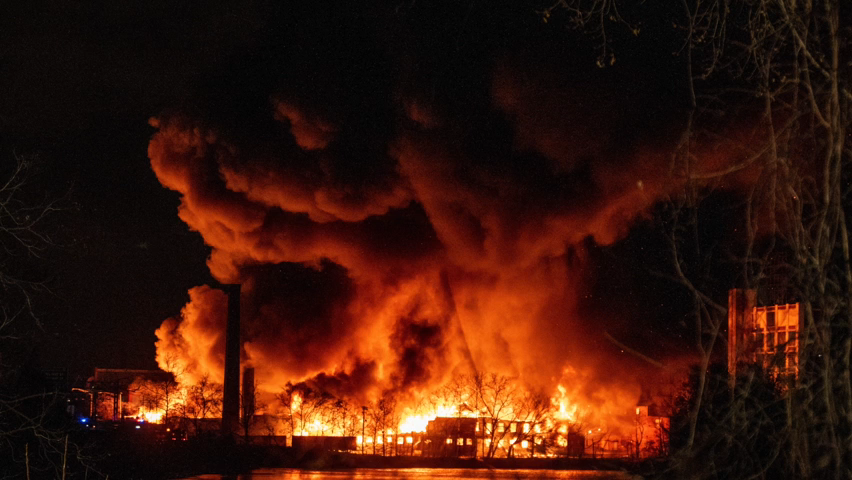Booker: EPA must strengthen chemical safety regulations after NJ fire | Opinion
Editor's note: This week, Sen. Cory Booker called on the U.S. Environmental Protection Agency to strengthen its regulations that cover some of the biggest chemical plants in New Jersey. A letter sent from Booker to EPA Administrator Michael Regan on Wednesday came a week after NorthJersey.com published a series called "Hazards Next Door" that showed how close dozens of facilities that store hazardous materials are to homes, schools and parks, especially in some of New Jersey's poorest communities. This is an adapted version of Booker's letter:
The Honorable Michael S. ReganAdministratorU.S. Environmental Protection Agency1200 Pennsylvania Avenue NWWashington, D.C. 20460
Dear Administrator Regan:
We write to express our appreciation and support for your agency’s work to protect Americans from chemical disasters by issuing the Safer Communities by Chemical Accident Prevention proposed rule. As the Environmental Protection Agency (EPA) works to finalize the rule, we write to reiterate our earlier call for you to deliver the strongest possible protections for workers in Risk Management Program (RMP) facilities, first responders, and environmental justice communities who live near these facilities and are most vulnerable to the cumulative impacts of chemical exposure. As you know, the RMP, as conceived in Section 112 of the Clean Air Act, was intended as a tool to prevent chemical facility disasters but to date the program has been largely reactive. After the prior administration rolled back safety measures that ignored both the statute's core prevention objectives and the facts showing a strong need for action to prevent chemical disasters, EPA is making the right decision to change course and follow the science and the law. With this new rulemaking, EPA has the opportunity to finally fulfill the promise of the Act by making the proposed improvements, and by further strengthening the rule to prevent chemical disasters from happening in the first place.

Recent chemical disasters have highlighted shortcomings in federal regulations that fail to sufficiently protect workers and communities living near hazardous chemical facilities. From 2004-2020, EPA found that industry reported a total of 3,425 incidents, and acknowledged both reporting delays and under-reporting. This does not account for near-misses, and some of these events could have been much worse if not for highly trained workers acting to prevent a more disastrous outcome. For example, just earlier this year, a chemical fire at a facility in Passaic, New Jersey nearly reached a warehouse storing three million pounds of chemicals, including chlorine pellets.
Catastrophe was largely averted due to the efforts of roughly 200 firefighters who worked for three days to keep the fire contained while nearby residents sheltered in place. As climate change continues to drive more frequent and intense severe weather, EPA must also do more to protect communities from the “double disasters” that result when chemical disasters coincide with earthquakes and extreme weather events like hurricanes, floods, and wildfires. AFebruary 2022 Government Accountability Office (GAO) report highlighted this need, finding that roughly a third of RMP facilities are at increased risk from climate impacts and that the current RMP rule does not adequately protect against these climate risks.
Special report:What's lurking next door? Investigation reveals chemical hazards near North Jersey homes
Our view:Too many in NJ live near hazardous materials. This is what lawmakers must do
We are encouraged by the steps that EPA has taken with this proposed rule toward protecting communities from the danger of chemical disasters, and we urge the agency to further strengthen the rule in several key ways. As many of us wrote to you in April of last year, the updated RMP rule should prioritize hazard reduction and prevention measures, including transitioning to inherently safer chemicals and processes and requiring third-party audits to verify compliance. However, the proposed rule excludes the vast majority — 95% — of RMP facilities from the requirement to conduct a Safer Technologies and Alternatives Analysis (STAA), and in most cases only requires a third-party audit after two incidents have occurred. We encourage EPA to broadly require the transition to inherently safer chemicals and processes at RMP facilities, and to lower the threshold that prompts third-party compliance audits. In addition, given EPA’s mandate to prioritize environmental justice established in E.O. 13990, “Protecting Public Health and the Environment and Restoring Science to Tackle the Climate Crisis,” we urge the agency torequire cumulative impact assessments as part of stationary source siting evaluations in the final rule.
To further ensure adequate protections for the millions of Americans that live near RMP facilities, the final rule should improve requirements for outreach to inform the public about RMP facility hazards and emergency response plans before and during incidental releases, and require that this information be made available in multiple languages. To foster information access and transparency, EPA should maintain a publicly accessible RMP database and commit to delivering that database on the fastest possible timeline.
To adequately recognize and protect chemical facility workers and their unions as key partners in incident prevention, the final rule should: expand the conditions in which workers and their representatives are granted stop work authority; ensure that authority extends to workers in all RMP facilities regardless of program level; clarify and require safety reporting that better protects workers’ anonymity; allow workers and their representatives to be meaningfully involved in all elements of the rule; require employers to provide workers information and training about the rule and to develop a written program to ensure there is no retaliation against employees for using their rights to prevent a chemical disaster.
Lastly, we commend the EPA for taking steps to recognize climate change as a threat multiplier and proposing important requirements to assess and plan for natural hazards and power loss. We encourage EPA to strengthen these provisions by also requiring implementation of mitigation measures to prevent these climate-related “double disasters”, as emphasized in the GAO’s February 2022 report. Additionally, the proposed rule does not require real-time air fenceline monitoring, leak detection, nor full facility back-up power, and would be strengthened by each of these requirements. We also note concerns about air monitoring and control equipment being removed from service before extreme weather events, as occurred during Hurricane Harvey, which leaves community members and regulators in the dark as to the full extent of air pollution and chemical disasters that may be exacerbated by extreme weather and/or power loss. The final rule can be strengthened by requiring penalties for intentionally removing air monitoring and control equipment from service, including before extreme weather events.
Thank you for your ongoing work on this and other environmental justice issues. We look forward to continuing to work with you to ensure that the communities we represent, and those across the country, are protected from the danger of chemical disasters by a truly preventative Risk Management Program.
Sincerely,
Cory A. Booker, United States Senator
Nanette Diaz Barragán, Member of Congress
Thomas R. Carper, United States Senator
Lisa Blunt Rochester, Member of Congress
Tammy Baldwin. United States Senator
Suzanne Bonamici, Member of Congress
Benjamin L. Cardin, United States Senator
Tony Cárdenas, Member of Congress
Tammy Duckworth, United States Senator
André Carson, Member of Congress
Richard J. Durbin, United States Senator
Steve Cohen, Member of Congress
Dianne Feinstein, United States Senator
Mark DeSaulnier, Member of Congress
Edward J. Markey, United States Senator
Debbie Dingell, Member of Congress
Robert Menendez, United States Senator
Adriano Espaillat, Member of Congress
Jeffrey A. Merkley, United States Senator
John Garamendi, Member of Congress
Alex Padilla, United States Senator
Robert Garcia, Member of Congress
Bernard Sanders, United States Senator
Raúl M. Grijalva, Member of Congress
Chris Van Hollen, United States Senator
Val Hoyle, Member of Congress
Elizabeth Warren, United States Senator
Jared Huffman, Member of Congress
Sheldon Whitehouse, United States Senator
Ro Khanna, Member of Congress
Ron Wyden, United States Senator
Barbara Lee, Member of Congress
Doris Matsui, Member of Congress
Betty McCollum, Member of Congress
Jerrold Nadler, Member of Congress
Grace F. Napolitano, Member of Congress
Eleanor Holmes Norton, Member of Congress
Mark Pocan, Member of Congress
Jamie Raskin, Member of Congress
Mary Gay Scanlon, Member of Congress
Adam Smith, Member of Congress
Melanie Stansbury, Member of Congress
Haley M. Stevens, Member of Congress
Dina Titus, Member of Congress
Rashida Tlaib, Member of Congress
Jill Tokuda, Member of Congress
Paul D. Tonko, Member of Congress
Maxine Waters, Member of Congress
Bonnie Watson Coleman, Member of Congress

This article originally appeared on NorthJersey.com: Booker: EPA must strengthen chemical safety regulations after NJ fire

